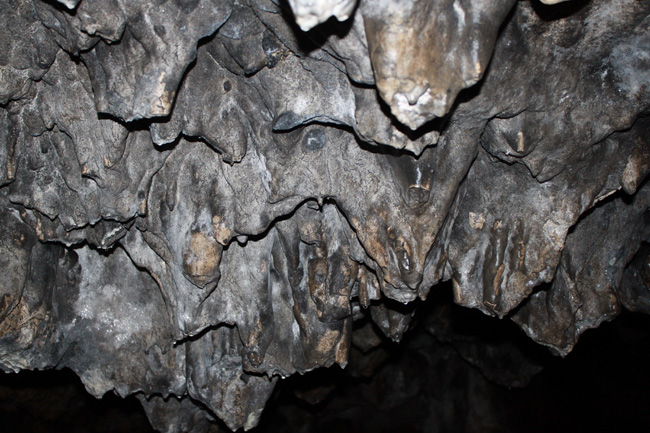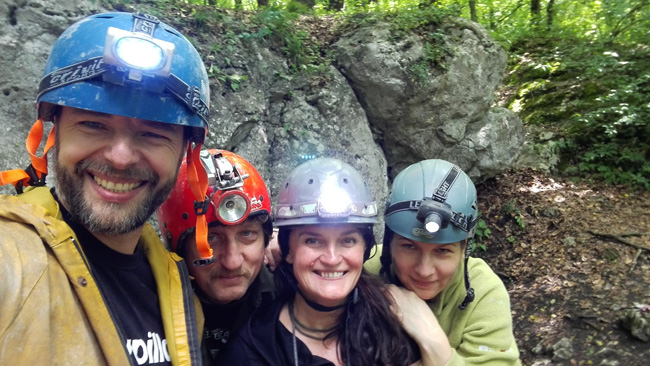Be smart, be an EarthCacher - geology rulez! ;)

Acknowledgment: Monika Krzeczyńska MSc / Polish Geological Institute-National Research Institute
Podziękowanie: mgr Monika Krzeczyńska / Państwowy Instytut Geologiczny-Państwowy Instytut Badawczy

Stoisz przed otworem Jaskini w Zielonej Górze (geneza nazwy – oczywista) na obszarze rezerwatu leśnego Zielona Góra. Jak większość jaskiń Jury Krakowsko-Częstochowskiej, ta również uformowana została w skałach wapiennych w wyniku tzw. procesów krasowych – czyli rozpuszczania ich głównego składnika (węglanu wapnia CaCO3) przez wody atmosferyczne. Jaskinia ma przebieg poziomy, łączna długość jej korytarzy wynosi ok. 140.

Jaskinia w Zielonej Górze, szata naciekowa / photo & background photo: hanbei
Przenieś się w wyobraźni do wnętrza naszej jaskini. Znajdujesz się w obszernej sali. Wokół panuje cisza zakłócona jedynie tępym dźwiękiem kropel wody kapiących ze stropu na gliniaste podłoże pokryte różnej wielkości fragmentami skalnymi. Jest chłodno, a odczucie to potęguje duża wilgotność powietrza. Rozglądasz się wokół: w głębi sali dostrzegasz pionowe, nieregularne kształty, które przy przesuwaniu źródła światła zdają się poruszać względem siebie. To tylko złudzenie! z bliska spostrzegasz: jest to „las” masywnych kolumn naciekowych tworzących istny labirynt i odgradzających Cię od kolejnej salki. Gra świateł i cieni w komnacie magicznych kolumn pobudza Twoją wyobraźnię: nagle postrzegasz obok siebie „końskie nogi” (zdjęcie tła), kształty ożywają! Wróć do rzeczywistości J. Te wspaniałe formy, które Cię otaczają to szata naciekowa jaskini – czyli ten jej skarb, który zwykle najbardziej przyciąga swym urokiem.

Kwartet Założycielski ;) / photo: hanbei
Jak powstają takie kolumny? Spójrz na strop jaskini: zapewne zauważysz zwisające gdzieniegdzie krople wody. Pochodzą one z krążących w masywie skalnym wód atmosferycznych. Krople takie często znajdują się na końcach „kamiennych sopli” – tzw. stalaktytów, które powstają, gdy z wody wytrąca się rozpuszczony w niej wcześniej węglan wapnia. (pierwsze zdjęcie w listingu) Stalaktyty „rosną w dół”. Jak to zapamiętać? Otóż słowo „stalaktyt” zawiera literę „Y”, która kształtem przypomina zwisający z góry „sopel”. Gdy kropla w końcu spadnie na podłoże, a zawiera w sobie jeszcze trochę węglanu wapnia, w tym miejscu następuje jego krystalizacja – powstaje stalagmit rosnący do góry. (Słowo „stalagmit” zawiera literę „i” podobną do laskowej formy nacieku, na który kapie kropla wody).
W miarę wzrostu obydwu form zbliżają się one do siebie, aż ulegną połączeniu tworząc kolumnę naciekową (zdjęcie tła). Kolumny naciekowe mogą przyjmować rozmaite kształty w zależności m. in. od szybkości wzrostu czy kierunku i prędkości przepływu powietrza w jaskini.
Odpowiedzi proszę wysyłać za pomocą mojego profilu. Nie trzeba czekać na moją odpowiedź, można od razu logować. Jeśli coś będzie nie tak, zgłoszę się sam. Pamiętajcie proszę, że logi bez podesłanych odpowiedzi będą kasowane.
ZADANIA
- Jak nazywają się zwyczajowo pierwotne, niezakłócone formy stalaktytów, przybierające postać cienkiej rurki, mogącej osiągać nawet 2 m długości?
- Jaka jest zasadnicza różnica w budowie między stalaktytem i stalagmitem?
- Dlaczego kolumny naciekowe w tej jaskini są w dużej mierze czarne?
- Po prawej stronie od otworu jaskini (stojąc przodem do jej otworu) – na południe od niego, za załomem skalnym znajduje się duża wklęsłość w skale (po oderwaniu się bloku skalnego). Zmierz jej średnicę.
- Zadanie opcjonalne: a może i tu jakaś "sweet focia" ;)

Cave in Zielona Góra
You are standing right at the entrance to the Cave in Zielona Góra (“green mountain”) in Zielona Góra forest reserve. Similarly to other caves in Kraków-Częstochowa Upland, this cave was also formed in limestone as a result of karst processes - dissolution of calcium carbonate (CaCO3) by rainwater and groundwater charged with carbonic acid (H2CO3) and naturally occurring organic acids.
The cave is horizontal, total length of all passages is around 140 meters.
Now close your eyes and imagine you are inside the cave. You are standing in the middle of spacious chamber. All around you everything is silent. The only sound you can hear comes from the water drops falling from the ceiling on the muddy cave floor. The floor is covered with rocks of all sizes. Now look around you: in the distance you can see a vertical irregular shapes, that seem to dance when you move your flashlight. But fear not: it’s just an illusion! When you look closer you can see that it is a “forest” of massive columns (pillars) that create a true labyrinth. It separates you from the next chamber. The play of light and shadows stirs your imagination. Suddenly you can see an “elephant leg” right beside you and the shapes come to life!
Now come back to reality ;) These wonderful forms and shapes you saw are part of the speleothem or cave formation – it’s a true treasure that lures with its beauty.
How these columns are created? Look at the cave ceiling. You can see water drops that are hanging and falling from it. This water comes from rains and, as it penetrates and moves inside the ground and rocks, it dissolves them. When the drops are hanging from the ceiling they leave the dissolved substances (mainly calcium carbonate) that crystallizes and forms a structure that grows downwards. This structure is called stalactite. After the drop falls on the floor it leaves the rest of dissolved calcium carbonate at the place of the fall, creating a structure that grows upwards. This one is called stalagmite. When the two structures grow they may meet in the middle. That’s how a column (pillar) is made.
Columns may have different shapes depending on the speed of the growth or direction and velocity of air movement in the cave.
You can send answers via my profile. You do not need to wait for my answer, you can log instantly. If something is wrong I will contact you myself. Please remember that logs without answers will be deleted.
TASKS
- What is the name of a primary, not disturbed, form of stalactite that looks like a long (up to 2 meters) and narrow tube?
- Even though stalactite and stalagmite may seem similar in shape, there is a structural difference between them. What is this difference?
- Why columns in this cave are mostly black?
- On the right side of the cave entrance (when you stand facing the entrance) – south of it, right around the rocky bend, there is a concave structure. It’s a leftover from rock block break off. What is the diameter of the concave structure?
- Optional: what about a photo?
